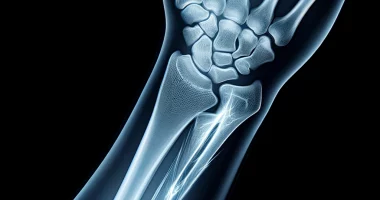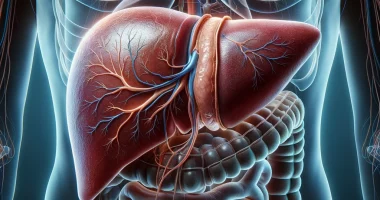Hemothorax
Definition
Hemothorax is bleeding into the pleural cavity, accumulation of blood between its sheets, leading to compression of the lung and displacement of mediastinal organs to the opposite side. In hemothorax, there is pain in the chest, difficulty breathing, and signs of acute blood loss (dizziness, pale skin, tachycardia, hypotension, cold, clammy sweat, and fainting). Diagnosing hemothorax is based on physical findings, fluoroscopy and chest radiography, CT, and diagnostic pleural puncture results. Treatment of hemothorax includes hemostatic, antibacterial, symptomatic therapy; aspiration of accumulated blood (puncture, drainage of the pleural cavity), if necessary – open or videothoracoscopic removal of coagulated hemothorax, stopping ongoing bleeding.
General information
Hemothorax is the second most frequent (after pneumothorax) complication of chest trauma and occurs in 25% of patients with thoracic trauma. A combined pathology – hemopneumothorax – is often observed in clinical practice. The danger of hemothorax lies both in the growing respiratory failure caused by lung compression and in the development of hemorrhagic shock due to acute internal bleeding. In pulmonology and thoracic surgery, hemothorax is considered an emergency requiring emergency specialized care.
Causes of hemothorax
There are three groups of causes that most often lead to the development of hemothorax: traumatic, pathologic, and iatrogenic.
- Traumatic causes are understood as penetrating wounds or closed injuries of the thorax. Thoracic trauma accompanied by hemothorax development includes road traffic accidents, gunshot and knife wounds of the thorax, rib fractures, falls from heights, and others. Such traumas quite often cause damage to organs of the thoracic cavity (heart, lungs, diaphragm), abdominal organs (liver, spleen injuries), intercostal vessels, internal thoracic artery, intrathoracic branches of the aorta, blood from which pours into the pleural cavity.
- The causes of hemothorax of pathological nature include various diseases: cancer of the lung or pleura, aortic aneurysm, pulmonary tuberculosis, lung abscess, neoplasms of the mediastinum and chest wall, hemorrhagic diathesis, coagulopathies, and others.
- Iatrogenic factors leading to hemothorax development are lung and pleura operation complications, thoracocentesis, pleural cavity drainage, and central vein catheterization.
Classification
According to the etiology, traumatic, pathologic, and iatrogenic hemothorax are distinguished. Taking into account the magnitude of intrapleural hemorrhage hemothorax can be:
- small – the volume of blood loss up to 500 ml, accumulation of blood in the sinus;
- medium – volume up to 1.5 liters, blood level to the lower edge of the IV rib;
- subtotal – the volume of blood loss up to 2 liters, the blood level to the lower edge of the II rib;
- total – the volume of blood loss more than 2 liters, radiologically characterized by total darkening of the pleural cavity on the side of the lesion.
The amount of blood pouring into the pleural cavity depends on the localization of the wound and the degree of vascular destruction. Thus, when the peripheral parts of the lung are injured, there is usually a small or medium hemothorax; when the lung root is injured, the main vessels are usually damaged, which is accompanied by massive hemorrhage and the development of subtotal and total hemothorax.
In addition, it also distinguishes a limited hemothorax, in which the spilled blood accumulates between the pleural adhesions in an isolated area of the pleural cavity.
In the case of continued intrapleural bleeding, we speak of a growing hemothorax; in the case of cessation of bleeding, it is stable. Complicated types include coagulated and infected hemothorax (pyohemothorax).
Symptoms of hemothorax
Clinical symptoms of hemothorax depend on the degree of bleeding, compression of lung tissue, and displacement of mediastinal organs. In small hemothorax, clinical manifestations are minimal or absent. The main complaints are chest pain, increased coughing, and moderate dyspnea.
In a hemothorax of medium or large size, respiratory and cardiovascular disorders, expressed in varying degrees, develop. Sharp pain in the chest, irradiating to the shoulder and back when breathing and coughing, general weakness, tachypnea, and decreased BP are characteristic. Even with a slight physical load, there is an increase in symptomatology. The patient usually takes a forced sitting or semi-sitting position.
In severe hemothorax, the clinic of intrapleural hemorrhage comes to the fore: weakness and dizziness, cold, clammy sweat, tachycardia and hypotension, pallor of the skin with cyanotic tint, flickering flies before the eyes, fainting.
Hemothorax associated with rib fracture is usually accompanied by subcutaneous emphysema, soft tissue hematomas, deformation, pathologic mobility and crepitation of rib fragments. Hemothorax with rupture of pulmonary parenchyma may cause hemoptysis.
In 3-12% of cases, a coagulated hemothorax is formed, in which blood clots, fibrin layers are formed in the pleural cavity, limiting the respiratory function of the lung, causing the development of sclerotic processes in the lung tissue. The clinic of coagulated hemothorax is characterized by heaviness and pain in the chest, dyspnea. In infected hemothorax (pleural empyema), signs of severe inflammation and intoxication come to the fore: fever, chills, lethargy, etc.
Diagnosis
To make a diagnosis, the details of the history of the disease are clarified, and physical, instrumental, and laboratory examinations are performed. In hemothorax, it is determined that there is lagging of the affected side of the chest when breathing, dulling of the percussion sound above the level of fluid, weakening of breathing, and vocal tremor. Fluoroscopy and review radiography of the lungs reveals lung collapse, the presence of a horizontal level of fluid or clots in the pleural cavity, and displacement of the mediastinal shadow to the healthy side.
A pleural puncture is performed for diagnostic purposes: obtaining blood reliably indicates hemothorax. The puncture specimen is sent to the laboratory for hemoglobin determination and bacteriological examination.
In trivial and coagulated hemothorax, laboratory determination of Hb, erythrocyte count, platelet count, and coagulogramstudy are used. Additional instrumental diagnostics in hemothorax may include ultrasound of the pleural cavity, ribradiography, chest CT, and diagnostic thoracoscopy.
Hemothorax treatment
Patients with hemothorax are hospitalized in specialized surgical units and are under the care of a thoracic surgeon. For therapeutic purposes, to aspirate/evacuate blood, the pleural cavity is drained with antibiotics and antiseptics into the drainage (to prevent infection and sanitation) and proteolytic enzymes (to dissolve clots). Conservative treatment of hemothorax includes hemostatic, antiplatelet, symptomatic, immunocorrective, hemotransfusion therapy, general antibiotic therapy, oxygen therapy.
Small hemothorax can, in most cases, be eliminated conservatively. Surgical treatment is indicated in cases of ongoing intrapleural bleeding, coagulated hemothorax preventing lung expansion, and damage to vital organs.
In case of injury to large vessels or organs of the thoracic cavity, an emergency thoracotomy, ligation of the vessel, suturing of the lung or pericardial wound, and removal of the blood that has spilled into the pleural cavity are performed. Coagulated hemothorax is an indication for the planned performance of videothoracoscopy or open thoracotomy to remove blood clots and sanitation of the pleural cavity. In the case of suppuration of hemothorax, treatment is carried out according to the rules for managing purulent pleurisy.
All these treatment options are available in more than 530 hospitals worldwide (https://doctor.global/results/diseases/hemothorax). For example, Thoracentesis can be performed in these countries at following approximate prices:
Turkey $723 – in 27 clinics
China $2,232 – in 7 clinics
Germany $2,680 – in 26 clinics
Israel $3,208 – in 13 clinics
United States $4,125 – 5,830 in 11 clinics
Prognosis and prevention
The success of hemothorax treatment is determined by the nature of the injury or disease, the intensity of blood loss, and the timeliness of surgical care. The prognosis is most favorable in small and medium-sized uninfected hemothorax. A coagulated hemothorax increases the likelihood of developing pleural empyema. Continued intrapleural hemorrhage or a single large blood loss may lead to the patient’s death.
The outcome of hemothorax may be the formation of massive pleural adhesions that limit the mobility of the diaphragm dome. Therefore, during rehabilitation, swimming and breathing exercises are recommended for patients who have undergone hemothorax. Prevention of hemothorax consists of preventing traumatism, mandatory consultation of patients with thoracoabdominal trauma by a surgeon, control of hemostasis during operations on the lungs and mediastinum, and careful performance of invasive manipulations.


